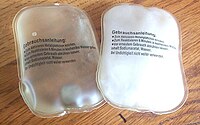
Photo from wikipedia
Abstract Respirators with a thermal therapy function allow patients suffering from allergic rhinitis to be treated conveniently. Herein, a thermal therapy respirator was explored by introducing a block of composite… Click to show full abstract
Abstract Respirators with a thermal therapy function allow patients suffering from allergic rhinitis to be treated conveniently. Herein, a thermal therapy respirator was explored by introducing a block of composite phase change material (PCM) into a commercial mask. To select a suitable phase change temperature for the block, two paraffin waxes with different melting points were selected as the PCMs. These were then combined with styrene-ethylene-butadiene-styrene (SEBS) to prepare composites, and subsequently formed into blocks by hot pressing. Suitable mass fractions of the two paraffin waxes were determined as approximately 75%, at which point the obtained composite phase change blocks were form-stable. The freezing temperatures of the two form-stable composite blocks were measured as 52.96 and 59.70 °C, and their freezing enthalpies were 143.9 and 140.0 J g−1. The two types of blocks, and another SEBS-based block not containing an active PCM were placed into the filter box of a commercial silicon mask to manufacture three types of respirators. Experimental investigations revealed that the inhaled air was maintained at temperatures above 43 °C for durations that varied for the three different kinds of respirators. In particular, only the respirator equipped with the block containing paraffin having the highest freezing point achieved the thermal therapy requirement. This work highlights a simplistic method of developing thermal therapy respirators.
Journal Title: International Journal of Thermal Sciences
Year Published: 2019
Link to full text (if available)
Share on Social Media: Sign Up to like & get
recommendations!